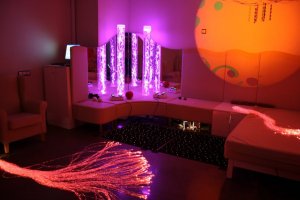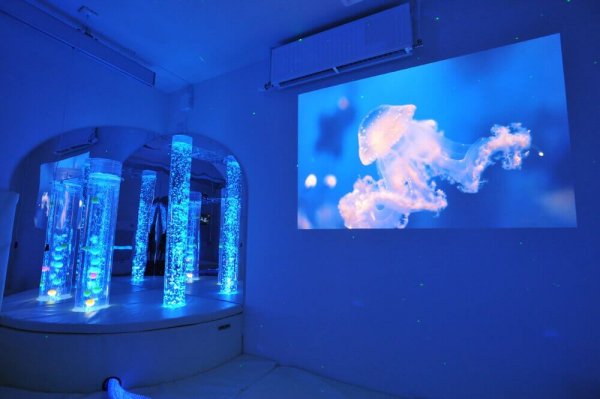Have You Heard of Snoezelen Multi-Sensory Stimulation Rooms?

Maybe you’ve heard of Snoezelen rooms. You’ve probably run into the concept of “multi-sensory stimulation” at least once. In this article we’re going to tell you about the origins and roots of these strange rooms. And then we’ll go into how they can help you.
The term “Snoezelen” originates from two Dutch words put together. On the one hand you have “snoffelen”, which means to smell. On the other hand you have “doezelen”, which is something like to relax or to nap.
So what this means is an association between two actions that seem like they’re naturally different. It’s something like achieving relaxation through stimulation – finding and enjoying the nice part of stimulating your senses.
Snoezelen rooms came about to help people with developmental disorders
The Snoezelen concept came about just like big ideas and putting solutions into motion do. It came about from a need to act. A need to confront the paralysis and lack of action in a specific part of life.
It came about, in this case, from a frustration in seeing what the treatment for people with developmental disorders was like, and how they didn’t get the results they wanted.
The treatment never went beyond anything but aid work. But Ad Verheul and Jan Hulsegge, the fathers of this revolutionary concept, didn’t think that was good enough. They came up with this new way of helping people that we’ll talk about now.
So, of course, some people especially benefit from this kind of therapy. We’re mostly talking about those who have a very low ability to interact with others around them because of the limitations of their disorder. People with special needs, dementia, and autism benefit the most from this method.

Sensory stimulation helps you produce basic responses
For some people, stimulating them through different sensory channels can be a big help. This stimulation, when supervised and managed by a professional, will produce new responses in that person. They’re basic responses that these people have a hard time producing otherwise.
In this sense, you have to be familiar with that person’s case before you start to try and help them. All people are totally unique and different from everyone else. The way to help each specific person will depend on the quirks of their particular case.
Professionals have to know their patient very well to be able to get the most benefits out of this new kind of treatment. There are some people who need to “wake up.” These are people who have had, for example, brain damage that’s left them completely disconnected from the world around them.
When you stimulate and there are responses, you produce new neural connections
This procedure is also useful for people who are still connected to the world around them, and pay a lot of attention to it, but aren’t able to communicate. Those people benefit immensely from this therapy. Once you’re able to “wake up” what’s asleep, the stimulation will happen and you’ll produce new neural connections.
That’s why it’s essential to undertake personalized and detailed monitoring of the person. This is because you have to be able to perceive what’s imperceptible. The clinical eye will have to be fast, precise, and skilled in the subject it’s observing. You can’t let even the smallest detail escape you.
You have to be able to tell what the patient likes. What they find pleasant. What stimulus they respond to more, which sensory channel they’re most aware of…This is a difficult task that takes a lot of observation. It means a friendly, heartfelt observation of your patient.

Trust and harmony are necessary elements for sensory stimulation
So Snoezelen rooms are perfectly equipped to undertake this kind of therapy. The subject will have to be ready and prepared to produce these kinds of sensory experiences.
They’re experiences that involve each of the senses – sight, smell, touch, hearing, and taste. You should try to create a very humane environment. One where there’s room for trust, respect, and attention devoted to the person.
That will make it a pleasant space, and a special, unique getaway. It should be a space full of harmony and warmth that will definitely go farther than skin deep for the person, and settle inside them in one way or another. Just like nice, pretty melodies settle into our souls.
This text is provided for informational purposes only and does not replace consultation with a professional. If in doubt, consult your specialist.








